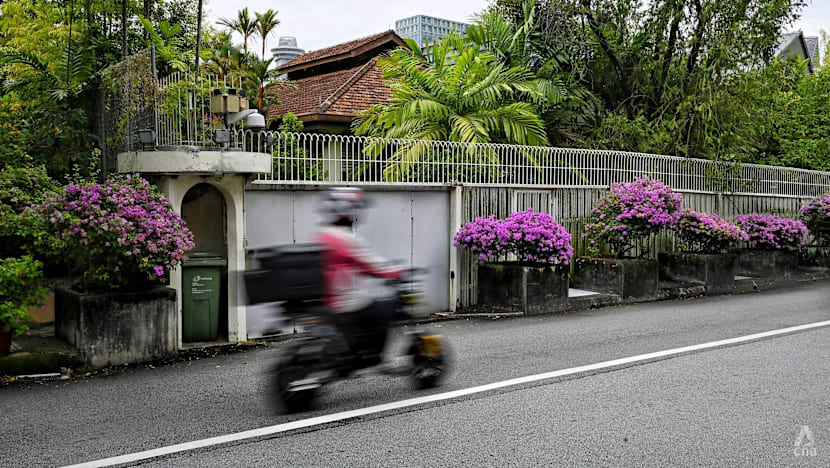Commentary: How Singapore preserves 38 Oxley Road site will be key for our young nation
The fate of the site could have broader implications for Singapore’s narrative and its citizens, says former NMP Nicholas Fang.

A delivery rider rides past the front gate of 38 Oxley Road, the estate of Singapore's first Prime Minister Lee Kuan Yew, on Nov 3, 2025. (Photo: CNA/Wallace Woon)

This audio is generated by an AI tool.
SINGAPORE: The recent announcement by the Singapore government of its intention to gazette 38 Oxley Road site as a national monument caused a minor stir in the country, and understandably so.
After all, it was the latest development in a long-running saga that has unfolded since Lee Kuan Yew’s death in 2015.
Singapore’s founding prime minister lived in the property from the 1940s until his death, and the bungalow was where his three children grew up. It also hosted meetings that led to the formation of the People’s Action Party (PAP) and many meetings of the country’s early leaders.
Tensions formed around the property following his death, with relations between Mr Lee’s eldest son and former prime minister Lee Hsien Loong and his two siblings souring over their father’s wish for the property to be destroyed.
While the majority of Singaporeans are unlikely to have ever stepped foot inside the property or have a clear memory of where exactly it is, the divisions between the Lee siblings have spilled over into the political realm and created buzz in parliament and outside of it.
The dust will eventually settle over the family feud, but how the fate of the property is resolved could have broader implications for Singapore’s national narrative and its citizens.

HISTORY FOR A YOUNG NATION
The key sticking point has been Mr Lee’s strenuous desire, expressed numerous times throughout his life and in his will, that his family home not be converted into a monument to himself after his death.
Some older Singaporeans who remember the early days of independence or subsequent generations who experienced Mr Lee Kuan Yew’s tenure could perhaps see it as a monument. But preserving the site is not about memorialising any single leader, as Acting Minister for Culture, Community and Youth David Neo said in parliament last week.
As a young nation of just 60 years, Singapore does not have as comprehensive and storied a history as older counterparts around the world, from which to draw lessons, insights for the future, and inspiration for current and future generations.
In today’s fast-paced and complex world, many of us are often swept away by a rapid tempo of education, work and life. The ubiquity of digital technology and social media contributes to shorter attention spans and lessened opportunities for contemplation and reflection.
A physical site that captures the trials and tribulations that the founding fathers underwent might serve to remind Singaporeans about our shared roots forged in challenging times, and instil a greater sense of pride and resilience.
SINGAPORE NOT ALONE IN REMEMBERING ITS HISTORY
The way memories of our history are preserved by future generations can potentially say more about the country and society – how and what we want to remember – than about the leaders themselves.
Mr Neo highlighted a few examples in his speech of other countries which have sought to preserve important spaces as a way to better understand their history. These included the Gandhi Ashram in India and the Independence National Historical Park in the US, two examples from countries with centuries of history.
The Gandhi Ashram, located on the banks of the Sabarmati River in Ahmedabad, was a home for Mahatma Gandhi from 1917 to 1930. But more importantly, it is where he launched the 24-day Dandi March to protest the British salt monopoly, an act that started a campaign of mass civil disobedience that was key to India’s eventual independence.
Meanwhile, the Independence National Historical Park in Philadelphia, Pennsylvania contains several sites significant in the American Revolution and the birth of the US, including important meeting sites where the Declaration of Independence and US Constitution were signed.
Some countries have also chosen to commemorate leaders’ residences for the insight offered into the way they lived and worked, by preserving such spaces with furniture or personal artefacts. These include former British Prime Minister Winston Churchill’s country house, Chartwell, and the home of Malaysia’s first prime minister at the Tunku Abdul Rahman Putra Memorial.
If Singapore aspires to continue building a national culture that can bond its citizens, we could study which options work for us and which do not.
RESPECTING HIS WISHES
Those who believe that the Oxley Road site should not be preserved would argue that Lee Kuan Yew had repeatedly expressed his wishes as such. His wife too had said she was against having parts of their private life together on display.
There is much to be said for respecting their wishes, and indeed admired about Mr Lee’s strong desire not to be memorialised in any way. The government has emphasised that it will maintain the Lees’ privacy, regardless of the final decision on the fate of the building.
It says a lot about a leader whose priority is not himself, but the work that he dedicated his life to, which in Mr Lee’s case was the building of a strong and resilient Singapore.
In today’s world, we see the rise of many strongman leaders whose key priorities seem to be self-aggrandisement and legacy-building with an emphasis on themselves.
Ironically, perhaps preserving the 38 Oxley Road site in a way that underscores Mr Lee’s priorities – that it should never be about him but about the process of nation-building – might be an invaluable reminder and example to future leaders about what true leadership and values look like.
As a young and forward-looking society, Singapore and its leaders constantly have their eyes on the future – both in terms of threats and opportunities. But conventional wisdom reminds us to remember where we came from, if we are to go further in the future.
How we see the 38 Oxley Road site as a marker of our history that we leave for future generations will have a major impact on our national narrative for years to come.


















